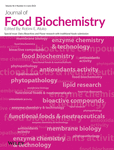Cinnamon could improve hepatic steatosis caused by a high-fat diet via enhancing hepatic beta-oxidation and inhibiting hepatic lipogenesis, oxidative damage, and inflammation in male rats
Abstract
Obesity is a health and medical problem and is known as the accumulation of fat that increases the risk of cardiovascular, type 2 diabetes mellitus, and infertility. Cinnamon is a spice that is used mainly as a flavoring additive and folk remedies to treat diabetes. Molecular mechanisms of its effects on hepatic lipogenesis and beta-oxidation, inflammation, and oxidative damage are not fully understood. Therefore, the aim of this study was to evaluate the protective and therapeutic effect of different doses of cinnamon in obese male rats. Forty-eight adult male Wister rats were randomly assigned into eight controlled and treated groups. Serum levels of lipid, glucose, and insulin profiles were measured along with liver levels of antioxidant enzymes, MDA and TNF-α. Hepatic expression of genes involved in beta-oxidation, lipogenesis, oxidative stress, and inflammation was also evaluated. Hepatic levels of oxidative and inflammatory biomarkers and serum levels of glucose, liver enzymes, insulin, and lipid profiles increased significantly in obese rats. Moreover, hepatic expression of SREBP-1c and NF-κB increased, and PPAR-alpha, CD36, FAS, CPT-1, and Nrf-2 decreased in obese rats. However, pretreatment and treatment with different doses of cinnamon in obese rats could significantly ameliorate them in obese rats. It can be concluded that cinnamon could improve hepatic steatosis caused by a high-fat diet via enhancing hepatic beta-oxidation and inhibiting hepatic lipogenesis, oxidative damage, and inflammation in male rats.
Practical applications
Obesity as a medical and psychiatric problem is seen in more than a third of the world's population. Obesity leads to cardiovascular disease, diabetes, and in some cases even death. Cinnamon as a spice and folk remedy has long been used as a treatment for obesity and liver disease. Cinnamon has received a great of attention from the past to the present due to its pharmacological properties and in addition to its availability, cheapness and low side effects. Cinnamon can prevent dyslipidemia, hyperglycemia, oxidative damage, and inflammation by modulating multiple signaling pathways. Our results showed that cinnamon could improve hepatic steatosis caused by HFD via enhancing hepatic beta-oxidation and inhibiting hepatic lipogenesis, oxidative damage, and inflammation. Therefore, it can be recommended that cinnamon and its products can be used as a very suitable option for the production of pharmaceutical supplements for the prevention and treatment of metabolic diseases.
CONFLICT OF INTEREST
The authors declare that they have no conflict of interest.
Open Research
DATA AVAILABILITY STATEMENT
The data that support the findings of this study are available from the corresponding author upon reasonable request.




